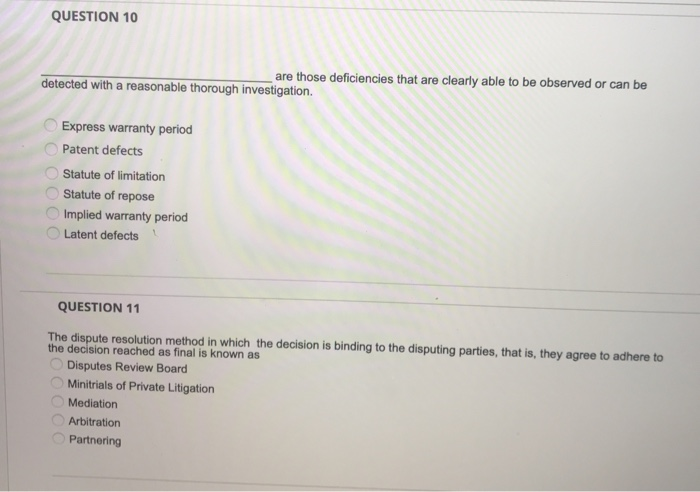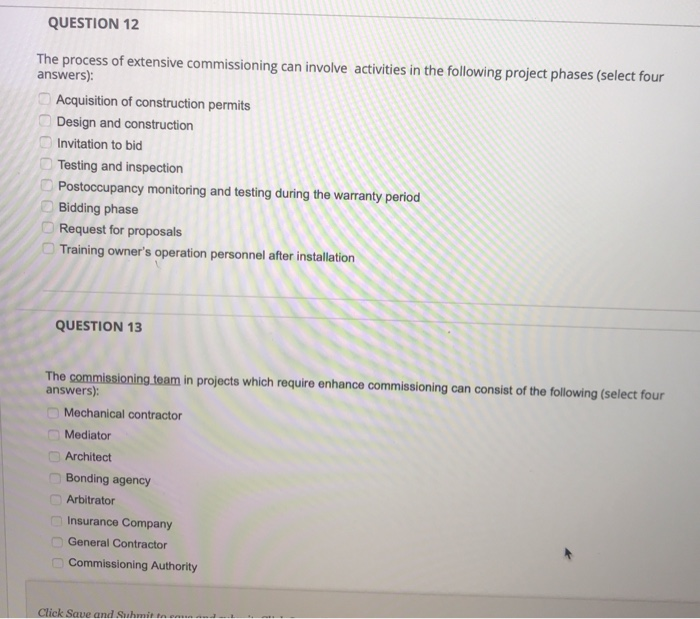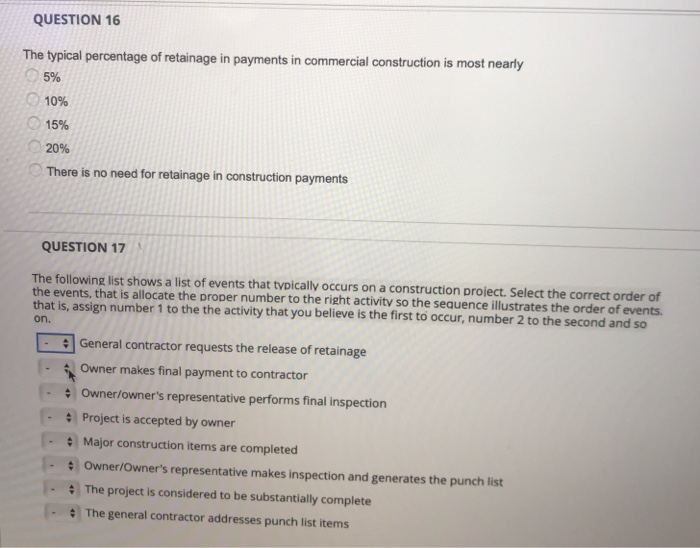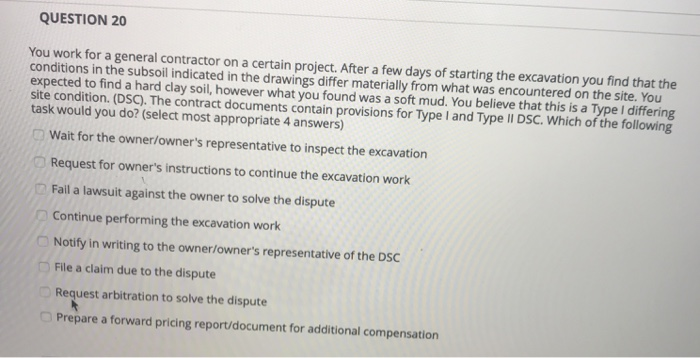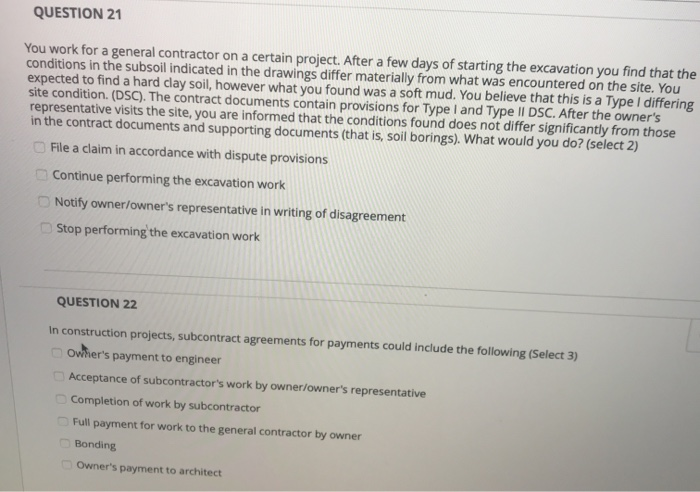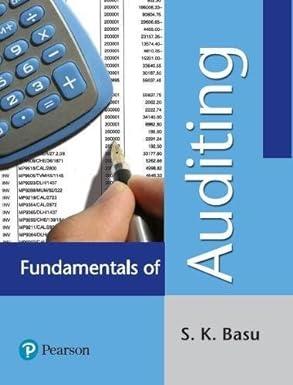QUESTION 10 are those deficiencies that are clearly able to be observed or can be detected with a reasonable thorough investigation. Express warranty period Patent defects Statute of limitation Statute of repose Implied warranty period Latent defects QUESTION 11 The dispute resolution method in which the decision is binding to the disputing parties, that is, they agree to adhere to the decision reached as final is known as Disputes Review Board Minitrials of Private Litigation Mediation Arbitration Partnering QUESTION 12 The process of extensive commissioning can involve activities in the following project phases (select four answers): Acquisition of construction permits Design and construction Invitation to bid Testing and inspection Postoccupancy monitoring and testing during the warranty period Bidding phase Request for proposals Training owner's operation personnel after installation QUESTION 13 The commissioning team in projects which require enhance commissioning can consist of the following (select four answers): Mechanical contractor Mediator Architect Bonding agency Arbitrator Insurance Company General Contractor Commissioning Authority Click Save and Submit Claims for Type I Differing Site Conditions can be denied if (select three answers): Lack of notice to the general contractor by the owner or owner's representative Conditions on site are not different or sufficiently different than reasonable expected Failure of a pre-bid site investigation by general contractor Lack of notice to the owner or owner's representative Conditions on site are sufficiently different than reasonable expected Lack of notice to the owner or owner's representative by the general contractor QUESTION 15 A key element to demonstrate a Type II Differing Site Condition during the recovery (additional compensation) process It is not possible to recover any additional expense due to the DSC Construction contract documents Comparison of the actual changed condition to what was in the drawings, specifications and any other supportive information Comparison of the actual changed condition to what was reasonable expected QUESTION 16 The typical percentage of retainage in payments in commercial construction is most nearly 5% 10% 15% 20% There is no need for retainage in construction payments QUESTION 17 The following list shows a list of events that typically occurs on a construction project. Select the correct order of the events, that is allocate the proper number to the right activity so the sequence illustrates the order of events. that is, assign number 1 to the the activity that you believe is the first to occur, number 2 to the second and so on. - - - - - - - General contractor requests the release of retainage Owner makes final payment to contractor Owner/owner's representative performs final inspection Project is accepted by owner Major construction items are completed Owner/Owner's representative makes inspection and generates the punch list The project is considered to be substantially complete The general contractor addresses punch list items If a construction contract does not have any clauses or provisions to address potential differing site conditions (DSC), the general contractor will likely increase the bid amount to address the additional risk True False QUESTION 19 If a construction contract does not have any clauses or provisions to address potential differing site conditions (DSC), the general contractor will likely reduce the contingency because it is sharing the risk with the owner. True False QUESTION 20 You work for a general contractor on a certain project. After a few days of starting the excavation you find that the conditions in the subsoil indicated in the drawings differ materially from what was encountered on the site. You expected to find a hard clay soil, however what you found was a soft mud. You believe that this is a Type I differing site condition. (DSC). The contract documents contain provisions for Type I and Type II DSC. Which of the following task would you do? (select most appropriate 4 answers) Wait for the owner/owner's representative to inspect the excavation Request for owner's instructions to continue the excavation work Fail a lawsuit against the owner to solve the dispute Continue performing the excavation work Notify in writing to the owner/owner's representative of the DSC File a claim due to the dispute Request arbitration to solve the dispute Prepare a forward pricing report/document for additional compensation QUESTION 21 You work for a general contractor on a certain project. After a few days of starting the excavation you find that the conditions in the subsoil indicated in the drawings differ materially from what was encountered on the site. You expected to find a hard clay soil, however what you found was a soft mud. You believe that this is a Type I differing site condition. (DSC). The contract documents contain provisions for Type I and Type II DSC. After the owner's representative visits the site, you are informed that the conditions found does not differ significantly from those in the contract documents and supporting documents (that is, soil borings). What would you do? (select 2) File a claim in accordance with dispute provisions Continue performing the excavation work Notify owner/owner's representative in writing of disagreement Stop performing the excavation work QUESTION 22 In construction projects, subcontract agreements for payments could include the following (Select 3) owher's payment to engineer Acceptance of subcontractor's work by owner/owner's representative Completion of work by subcontractor Full payment for work to the general contractor by owner Bonding Owner's payment to architect QUESTION 23 All extensions of time by ownerlowner's representative to contractors entitle contractor additional time and money to complete work. True False
